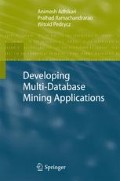Abstract
A number of important decisions are based on a set of specific items in a database called the select items. Thus the analysis of select items in multiple databases becomes of primordial relevance. In this chapter, we focus on the following issues. First, a model of mining global patterns of select items from multiple databases is presented. Second, a measure of quantifying an overall association between two items in a database is discussed. Third, we present an algorithm that is based on the proposed overall association between two items in a database for the purpose of grouping the frequent items in multiple databases. Each group contains a select item called the nucleus item and the group grows while being centered around the nucleus item. Experimental results are concerned with some synthetic and real-world databases.
Access this chapter
Tax calculation will be finalised at checkout
Purchases are for personal use only
References
Adhikari A, Rao PR (2007) Study of select items in multiple databases by grouping. In: Proceedings of the 3rd Indian International Conference on Artificial Intelligence, Pune, India, pp. 1699–1718
Adhikari A, Rao PR (2008a) Synthesizing heavy association rules from different real data sources. Pattern Recognition Letters 29(1): 59–71
Adhikari A, Rao PR (2008b) Efficient clustering of databases induced by local patterns. Decision Support Systems 44(4): 925–943
Aggarwal C, Yu P (1998) A new framework for itemset generation. In: Proceedings of the 17th Symposium on Principles of Database Systems, Seattle, WA, pp. 18–24
Agrawal R, Imielinski T, Swami A (1993) Mining association rules between sets of items in large databases. In: Proceedings of ACM SIGMOD Conference, Washington DC, pp. 207–216
Agrawal R, Shafer J (1999) Parallel mining of association rules. IEEE Transactions on Knowledge and Data Engineering 8(6): 962–969
Barte RG (1976) The Elements of Real Analysis. 2nd edition, John Wiley & Sons, New York
Chattratichat J, Darlington J, Ghanem M, Guo Y, Hüning H, Köhler M, Sutiwaraphun J, To HW, Yang D (1997) Large scale data mining: Challenges, and responses. In: Proceedings of the Third International Conference on Knowledge Discovery and Data Mining, pp. 143–146
Cheung D, Ng V, Fu A, Fu Y (1996) Efficient mining of association rules in distributed databases. IEEE Transactions on Knowledge and Data Engineering 8(6): 911–922
Frequent Itemset Mining Dataset Repository (2004) http://fimi.cs.helsinki.fi/data
Galambos J, Simonelli I (1996) Bonferroni-type Inequalities with Applications. Springer, New York
Jaroszewicz S, Simovici DA (2002) Support approximations using Bonferroni-type inequalities. In: Proceedings of Sixth European Conference on Principles of Data Mining and Knowledge Discovery, Helsinki, Finland, pp. 212–223
Klemettinen M, Mannila H, Ronkainen P, Toivonen T, Verkamo A (1994) Finding interesting rules from large sets of discovered association rules. In: Proceedings of the 3rd International Conference on Information and Knowledge Management, Gaithersburg, MD, pp. 401–407
Liu B, Hsu W, Ma Y (1999) Pruning and summarizing the discovered associations. In: Proceedings of the 5th International Conference on Knowledge Discovery and Data Mining, San Diego, CA, pp. 125–134
Pavlov D, Mannila H, Smyth P (2000) Probabilistics models for query approximation with large sparse binary data sets. In: Proceedings of Sixteenth Conference on Uncertainty in Artificial Intelligence, San Francisco, CA, pp. 465–472
Proefschrift (2004) Multi-relational data mining, Ph D thesis, Dutch Graduate School for Information and Knowledge Systems, Aan de Universiteit Utrecht
Pyle D (1999) Data Preparation for Data Mining. Morgan Kufmann, San Francisco
Silberschatz A, Tuzhilin A (1996) What makes patterns interesting in knowledge discovery systems. IEEE Transactions on Knowledge and Data Engineering 8(6): 970–974
Silverstein C, Brin S, Motwani R (1998) Beyond market baskets: Generalizing association rules to dependence rules. Data Mining and Knowledge Discovery 2(1): 39–68
Tan P-N, Kumar V, Srivastava J (2002) Selecting the right interestingness measure for association patterns. In: Proceedings of SIGKDD Conference, Alberta, Canada, pp. 32–41
Wu X, Zhang S (2003) Synthesizing high-frequency rules from different data sources. IEEE Transactions on Knowledge and Data Engineering 14(2): 353–367
Wu X, Zhang C, Zhang S (2005) Database classification for multi-database mining. Information Systems 30(1): 71–88
Xin D, Han J, Yan X, Cheng H (2005) Mining compressed frequent-pattern sets. In: Proceedings of the 31st VLDB Conference, Trondheim, Norway, pp. 709–720
Zhang S (2002) Knowledge discovery in multi-databases by analyzing local instances, Ph D thesis, Deakin University
Zhang C, Liu M, Nie W, Zhang S (2004a) Identifying global exceptional patterns in multi-database mining. IEEE Computational Intelligence Bulletin 3(1): 19–24
Zhang S, Wu X, Zhang C (2003) Multi-database mining. IEEE Computational Intelligence Bulletin 2(1): 5–13
Zhang S, Zhang C, Wu X (2004b) Knowledge Discovery in Multiple Databases. Springer, Berlin
Author information
Authors and Affiliations
Corresponding author
Rights and permissions
Copyright information
© 2010 Springer-Verlag London
About this chapter
Cite this chapter
Adhikari, A., Ramachandrarao, P., Pedrycz, W. (2010). Mining Patterns of Select Items in Multiple Databases. In: Developing Multi-Database Mining Applications. Advanced Information and Knowledge Processing. Springer, London. https://doi.org/10.1007/978-1-84996-044-1_4
Download citation
DOI: https://doi.org/10.1007/978-1-84996-044-1_4
Published:
Publisher Name: Springer, London
Print ISBN: 978-1-84996-043-4
Online ISBN: 978-1-84996-044-1
eBook Packages: Computer ScienceComputer Science (R0)

